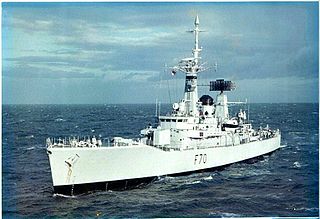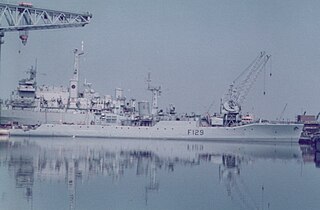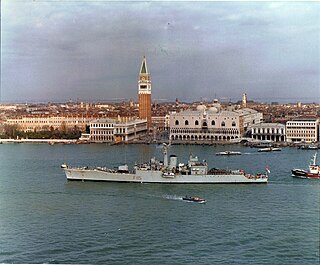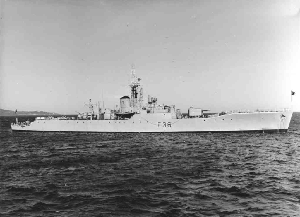
The Leander-class, or Type 12I (Improved) frigates, comprising twenty-six vessels, was among the most numerous and long-lived classes of frigate in the Royal Navy's modern history. The class was built in three batches between 1959 and 1973. It had an unusually high public profile, due to the popular BBC television drama series Warship. The Leander silhouette became synonymous with the Royal Navy through the 1960s until the 1980s.
HMS Minerva (F45) was a Leander-class frigate of the Royal Navy. The ship commissioned in 1966 and took part in the Beira Patrol and Second Cod War during the 1970s and the Falklands War in 1982. Charles, Prince of Wales served aboard the ship in the 1970s. Between these major engagements, the frigate patrolled British territorial waters and took part in NATO and British military exercises. Minerva was decommissioned in 1992 and sold for scrap.

HMS Plymouth was a Royal Navy Rothesay-class frigate. In 1982, Plymouth was one of the first Royal Navy ships to arrive in the South Atlantic during the Falklands War.

HMS Cleopatra (F28) was a Leander-class frigate of the Royal Navy (RN). Cleopatra was built at HMNB Devonport. She was launched on 21 March 1964, commissioned on 1 March 1966 and decommissioned on 31 January 1992.

HMS Danae was a Leander-class frigate of the Royal Navy. She was, like the rest of the class, named after a figure of mythology. Danae was built by Devonport Dockyard. She was launched on 31 October 1965 and commissioned on 10 October 1967.

HMS Mohawk was a Tribal-class frigate of the Royal Navy in service from 1963. She was named after a tribe of Native Americans located in southeast Canada and New York State. Mohawk was scrapped in 1983.

HMS Zulu (F124) was a Tribal-class frigate of the Royal Navy in service from 1964 to 1984. She was the third ship bearing the name of HMS Zulu, having been named after an ethnic group located primarily in KwaZulu-Natal Province, South Africa. Zulu was built by Alexander Stephen and Sons, of Govan. She was launched on 3 July 1962 and commissioned on 17 April 1964.

HMS Yarmouth was the first modified Type 12 frigate of the Rothesay class to enter service with the Royal Navy.

HMS Torquay was a Type 12 Whitby-class frigate of the British Royal Navy. They were the first frigates to have the "V" form hull. This evolutionary design made it possible to be driven in head sea without the usual slamming which occurs with conventional destroyers of the time. Each frigate cost 3.5 million pounds and the first ship completed was Torquay in May 1956.

The Rothesay class, or Type 12M frigates were a class of frigates serving with the Royal Navy, South African Navy and the Royal New Zealand Navy.

HMNZS Otago (F111) was a Rothesay-class frigate acquired from the United Kingdom by the Royal New Zealand Navy (RNZN) before completion.

HMS Rothesay was the lead ship of the Rothesay or Type 12M class of anti-submarine frigates of the British Royal Navy. She was commissioned in 1960 and scrapped in 1988.

HMS Londonderry was a Rothesay- or Type 12-class anti-submarine frigate of the British Royal Navy in service from 1960 to 1984.

HMS Brighton was a Rothesay or Type 12I class anti-submarine frigate of the Royal Navy.

HMS Falmouth was a Rothesay-class, or "Improved Type 12", anti-submarine frigate built for the Royal Navy during the 1950s. She took part in the Third Cod War in 1976, ramming the Icelandic gunboat V/s Týr. Both ships suffered extensive damage.

HMS Rhyl was a Rothesay-class or Type 12I anti-submarine frigate of the Royal Navy, launched by Lady Macmillan on 23 February 1959 and commissioned in October 1960. Following Royal Navy service she was scuttled whilst being prepared as a target in 1985.

HMS Berwick was a Rothesay- or Type 12I-class anti-submarine frigate of the British Royal Navy. She was built by Harland & Wolff and launched on 15 December 1959.

HMS Eastbourne was a Whitby-class, or Type 12, anti-submarine frigate of the Royal Navy of the United Kingdom.

HMS Tenby was a Whitby-class or Type 12 anti-submarine frigate of the Royal Navy of the United Kingdom.

HMS Whitby was a Whitby-class or Type 12 anti-submarine frigate of the Royal Navy of the United Kingdom built by Cammell Laird and Co Ltd, Birkenhead. She was launched on 2 July 1954 and commissioned on 10 July 1956.


















